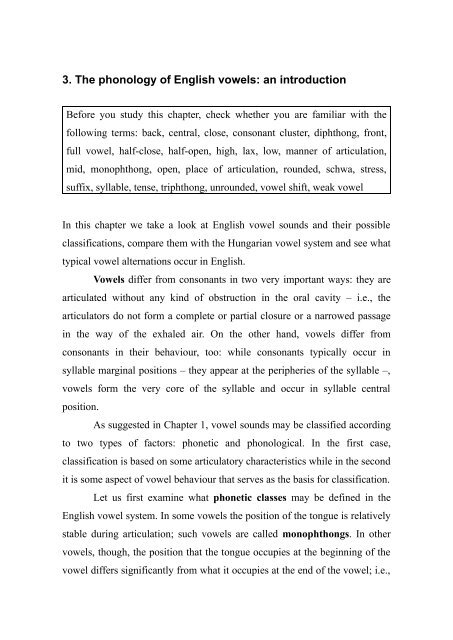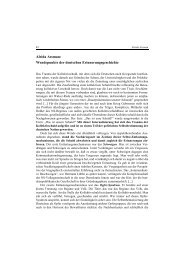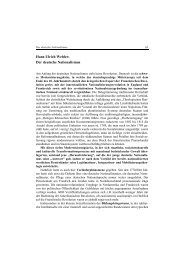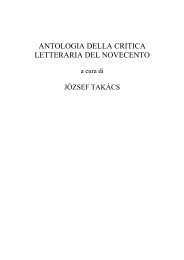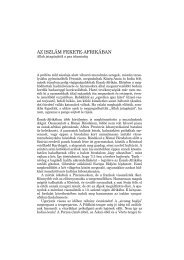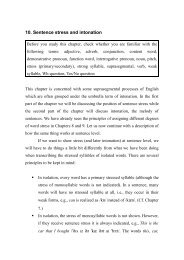3. The phonology of English vowels: an introduction
3. The phonology of English vowels: an introduction
3. The phonology of English vowels: an introduction
You also want an ePaper? Increase the reach of your titles
YUMPU automatically turns print PDFs into web optimized ePapers that Google loves.
<strong>3.</strong> <strong>The</strong> <strong>phonology</strong> <strong>of</strong> <strong>English</strong> <strong>vowels</strong>: <strong>an</strong> <strong>introduction</strong><br />
Before you study this chapter, check whether you are familiar with the<br />
following terms: back, central, close, conson<strong>an</strong>t cluster, diphthong, front,<br />
full vowel, half-close, half-open, high, lax, low, m<strong>an</strong>ner <strong>of</strong> articulation,<br />
mid, monophthong, open, place <strong>of</strong> articulation, rounded, schwa, stress,<br />
suffix, syllable, tense, triphthong, unrounded, vowel shift, weak vowel<br />
In this chapter we take a look at <strong>English</strong> vowel sounds <strong>an</strong>d their possible<br />
classifications, compare them with the Hungari<strong>an</strong> vowel system <strong>an</strong>d see what<br />
typical vowel alternations occur in <strong>English</strong>.<br />
Vowels differ from conson<strong>an</strong>ts in two very import<strong>an</strong>t ways: they are<br />
articulated without <strong>an</strong>y kind <strong>of</strong> obstruction in the oral cavity – i.e., the<br />
articulators do not form a complete or partial closure or a narrowed passage<br />
in the way <strong>of</strong> the exhaled air. On the other h<strong>an</strong>d, <strong>vowels</strong> differ from<br />
conson<strong>an</strong>ts in their behaviour, too: while conson<strong>an</strong>ts typically occur in<br />
syllable marginal positions – they appear at the peripheries <strong>of</strong> the syllable –,<br />
<strong>vowels</strong> form the very core <strong>of</strong> the syllable <strong>an</strong>d occur in syllable central<br />
position.<br />
As suggested in Chapter 1, vowel sounds may be classified according<br />
to two types <strong>of</strong> factors: phonetic <strong>an</strong>d phonological. In the first case,<br />
classification is based on some articulatory characteristics while in the second<br />
it is some aspect <strong>of</strong> vowel behaviour that serves as the basis for classification.<br />
Let us first examine what phonetic classes may be defined in the<br />
<strong>English</strong> vowel system. In some <strong>vowels</strong> the position <strong>of</strong> the tongue is relatively<br />
stable during articulation; such <strong>vowels</strong> are called monophthongs. In other<br />
<strong>vowels</strong>, though, the position that the tongue occupies at the beginning <strong>of</strong> the<br />
vowel differs signific<strong>an</strong>tly from what it occupies at the end <strong>of</strong> the vowel; i.e.,
<strong>The</strong> <strong>phonology</strong> <strong>of</strong> <strong>English</strong> <strong>vowels</strong>: <strong>an</strong> <strong>introduction</strong><br />
some tongue movement is involved. Such <strong>vowels</strong> are referred to as<br />
diphthongs (<strong>an</strong>d triphthongs). We may also think <strong>of</strong> this difference as a<br />
difference in how m<strong>an</strong>y <strong>vowels</strong> are found within one syllable: in<br />
monophthongs there is one – e.g., /, e, , , / –, in diphthongs there are<br />
two – e.g., /, , / – while in triphthongs there are three – e.g., /, /.<br />
Note though that triphthongs are not found in all dialects <strong>of</strong> <strong>English</strong>: those<br />
dialects that pronounce all underlying /r/'s – the so-called rhotic dialects, cf.<br />
Chapter 2 – typically lack triphthongs – <strong>an</strong>d even some <strong>of</strong> the diphthongs as<br />
we will show in Chapter 4.<br />
On the other h<strong>an</strong>d, <strong>vowels</strong> may be short – e.g. /, e, / – or long – e.g.,<br />
/, , , , / – depending on their duration: long <strong>vowels</strong> are<br />
approximately twice as long as short ones. Note that diphthongs <strong>an</strong>d<br />
triphthongs are just as long as long monophthongs. Whenever we refer to<br />
long <strong>vowels</strong>, we always me<strong>an</strong> long monophthongs, diphthongs <strong>an</strong>d<br />
triphthongs together. Note that length in <strong>English</strong> varies depending on the<br />
environment – i.e., length is not a stable property. For more on length<br />
alternations, see Chapter 6. <strong>The</strong> <strong>vowels</strong> <strong>of</strong> RP are the following:<br />
Short <strong>vowels</strong> Long <strong>vowels</strong><br />
, , , , , , i, u, , , , , , , , , , <br />
Monophthongs Diphthongs Triphthongs<br />
To further demonstrate that length is not a purely phonetic property <strong>of</strong><br />
<strong>English</strong> <strong>vowels</strong>, we may refer to the controversy <strong>of</strong> length marking: the<br />
vowel length <strong>of</strong> monophthongal – or pure – <strong>vowels</strong> is indicated with a colon.<br />
However, one <strong>of</strong> the so-called short monophthongs, the vowel // is just as<br />
long in actual pronunciation as <strong>an</strong>y <strong>of</strong> the long monophthongs or diphthongs<br />
<strong>an</strong>d it even undergoes the very same shortening process as long <strong>vowels</strong> do<br />
31
Chapter 3<br />
(see Chapter 6). However, its length is not indicated in tr<strong>an</strong>scription with the<br />
colon. <strong>The</strong> vowel // is categorized as a short vowel because it behaves like<br />
other short <strong>vowels</strong> do. <strong>The</strong> phonetic length <strong>of</strong> // may be due to the fact that<br />
during its production the lower jaw <strong>an</strong>d the tongue are in their most open<br />
position, a gesture which might take long enough to cause a perceivable<br />
length difference.<br />
Another import<strong>an</strong>t note concerning vowel length is due here: while<br />
most Hungari<strong>an</strong> short-long vowel pairs consist <strong>of</strong> <strong>vowels</strong> <strong>of</strong> more or less the<br />
same quality with just a length difference (e.g., /y/-/y/ tüze 'his/her/its fire'<br />
vs. tűz-e 'does he/she/it stitch?', //-// kör 'circle' vs. kőr 'hearts (in cards)',<br />
/i/-/i/ Sirok (a placename) vs. sírok 'I cry'), <strong>English</strong> short-long vowel pairs<br />
always involve a quality difference, that is, there is no <strong>English</strong> short-long<br />
vowel pair in which the qualities <strong>of</strong> the two <strong>vowels</strong> are the same. This is also<br />
reflected in the phonetic symbols used to indicate them. Consequently, while<br />
there is a short // <strong>an</strong>d a long /i/, there is no //; similarly, while there is a<br />
short // <strong>an</strong>d a long /u/, there is no //. <strong>The</strong> only exception to this rule is the<br />
vowel pair //-//, mentioned in Chapter 1, where the quality <strong>of</strong> the <strong>vowels</strong> is<br />
the same. However, in this case it is the full vowel-weak vowel distinction, to<br />
be discussed presently, that justifies the use <strong>of</strong> the different symbols.<br />
As far as phonological classifications <strong>of</strong> <strong>vowels</strong> are concerned, the<br />
two major phonological classes are based on the type <strong>of</strong> syllable the vowel<br />
appears in. <strong>English</strong> behaves quite differently from Hungari<strong>an</strong> as far as<br />
stressed <strong>an</strong>d unstressed syllables are concerned. On the one h<strong>an</strong>d, while it is<br />
always the first syllable <strong>of</strong> the word that carries the main stress in Hungari<strong>an</strong>,<br />
it may be the first, second, third, etc. syllable <strong>of</strong> <strong>an</strong> <strong>English</strong> word that carries<br />
primary stress. 1 On the other h<strong>an</strong>d, <strong>English</strong> unstressed syllables have reduced<br />
1 For the degrees <strong>of</strong> stress, see Chapter 8.<br />
32
<strong>The</strong> <strong>phonology</strong> <strong>of</strong> <strong>English</strong> <strong>vowels</strong>: <strong>an</strong> <strong>introduction</strong><br />
<strong>vowels</strong> only, in the sense that these <strong>vowels</strong> are shorter, weaker in energy <strong>an</strong>d<br />
closer to schwa // in place <strong>of</strong> articulation. Thus, in unstressed syllables only<br />
weak <strong>vowels</strong> – //, // <strong>an</strong>d // – may be found while in stressed syllables we<br />
may only find so-called full <strong>vowels</strong> – i.e., all the other <strong>vowels</strong> <strong>of</strong> <strong>English</strong>,<br />
also including // <strong>an</strong>d //, which, besides occurring in unstressed syllables,<br />
may also function as full <strong>vowels</strong>.<br />
Within the class <strong>of</strong> full <strong>vowels</strong> we may distinguish two subclasses:<br />
tense <strong>an</strong>d lax <strong>vowels</strong>. One has to be very careful when using these two terms<br />
as they are <strong>of</strong>ten used as phonetic labels, too. In a phonetic sense, these terms<br />
refer to the muscle bundles located at the backmost part <strong>of</strong> the tongue, against<br />
the back wall <strong>of</strong> the pharynx (throat). Whenever these muscles are tense, the<br />
vowel is tense (in a phonetic sense); when such muscle tenseness is not<br />
present, the vowel is lax (phonetically). However, we will use these terms in<br />
a purely phonological sense, i.e., to refer to a certain kind <strong>of</strong> vowel<br />
behaviour. (We might just as well call the two types <strong>of</strong> vowel Type1 <strong>an</strong>d<br />
Type2 was it not for our wish to follow the tradition.) As we will show below,<br />
tense <strong>an</strong>d lax <strong>vowels</strong> (in a phonological sense) occur in different types <strong>of</strong><br />
environment.<br />
Tense Lax<br />
Monophthongs i, u, 3<br />
, e, , , , , , , 1 , 2<br />
Diphthongs <strong>an</strong>d , , , , , , , ,<br />
triphthongs<br />
, <br />
<strong>The</strong>re are a few generalizations to be drawn on the basis <strong>of</strong> the above table:<br />
all short <strong>vowels</strong> are lax <strong>an</strong>d all diphthongs <strong>an</strong>d triphthongs are tense while<br />
long monophthongs are divided between the two classes. Non-high long<br />
monophthongs – that is //, // <strong>an</strong>d // – are lax, except in the case <strong>of</strong> // 3 .<br />
33
Chapter 3<br />
<strong>The</strong> behaviour <strong>of</strong> // is tw<strong>of</strong>old: sometimes it is tense, in other cases<br />
it is lax. <strong>The</strong>re are two general types <strong>of</strong> spellings that indicate a lax /:/ while<br />
a further set <strong>of</strong> spellings represents the tense vari<strong>an</strong>t.<br />
// 1<br />
// 2<br />
// 3<br />
Lax<br />
Tense<br />
No in spelling<br />
or in spelling in<br />
word-final position or followed<br />
by a conson<strong>an</strong>t letter<br />
in spelling followed by a<br />
(pronounced or silent) vowel<br />
letter<br />
, , , in<br />
spelling<br />
ball, called, saw, bought,<br />
broad, Shaw, clause, fault<br />
for, horde, morning,<br />
gorgeous, cord, north, war,<br />
dwarf, quarter, horn, sport<br />
before, histori<strong>an</strong>, store,<br />
more, adore, bored, shore<br />
soar, boar, roar, door, floor,<br />
four, pour, aura, Laura<br />
<strong>The</strong> behaviour <strong>an</strong>d alternations <strong>of</strong> tense <strong>an</strong>d lax <strong>vowels</strong> are discussed below<br />
<strong>an</strong>d also in Chapter 4, where we take a look at their behaviour before .<br />
<strong>The</strong> following table sums up what we have discussed about the m<strong>an</strong>ner <strong>of</strong><br />
articulation <strong>an</strong>d the behaviour <strong>of</strong> <strong>vowels</strong> so far.<br />
Full vowel<br />
lax tense<br />
short long long<br />
Weak<br />
vowel<br />
Monophthong , e, , , , , , i, u, , , <br />
Diphthong - - , , , , , , , -<br />
Triphthong - - , -<br />
Let us now turn to the places <strong>of</strong> articulation <strong>of</strong> <strong>vowels</strong>. Before we actually<br />
discuss these we have to point out that places <strong>of</strong> articulation are not as<br />
clearcut for <strong>vowels</strong> as for conson<strong>an</strong>ts for the very simple reason that while in<br />
conson<strong>an</strong>ts the place <strong>of</strong> articulation refers to the articulators producing some<br />
34
<strong>The</strong> <strong>phonology</strong> <strong>of</strong> <strong>English</strong> <strong>vowels</strong>: <strong>an</strong> <strong>introduction</strong><br />
degree <strong>of</strong> obstruction, in <strong>vowels</strong> it is simply inapplicable as they do not<br />
involve <strong>an</strong>y kind <strong>of</strong> obstruction. Instead <strong>of</strong> referring to obstruction sites, we<br />
will use three criteria to classify <strong>vowels</strong> according to horizontal tongue<br />
position, vertical tongue position <strong>an</strong>d lip rounding.<br />
following:<br />
<strong>The</strong> places <strong>of</strong> articulation <strong>of</strong> the monophthongs <strong>of</strong> RP are the<br />
Front Central Back<br />
unrounded unrounded unrounded rounded<br />
Close // beat - - // boot<br />
Half-close // bit // ago - // put<br />
Half-open /e/ bet<br />
// burn<br />
- // bought<br />
Open // bat // but // bar // Bob<br />
We have to note that besides the terms used in the table above, close <strong>vowels</strong><br />
are <strong>of</strong>ten referred to as high, open <strong>vowels</strong> as low, while the ones inbetween<br />
as mid. As it c<strong>an</strong> be seen from the above table the following generalizations<br />
may be drawn: front <strong>an</strong>d central <strong>vowels</strong> are unrounded while back <strong>vowels</strong> are<br />
rounded, except for //.<br />
following:<br />
<strong>The</strong> places <strong>of</strong> articulation <strong>of</strong> the diphthongs <strong>of</strong> RP are the<br />
Front Central Back<br />
unrounded unrounded unrounded rounded<br />
Close<br />
Half-close<br />
Half-open e<br />
<br />
<br />
Open a a<br />
// bay<br />
// bye<br />
// boy<br />
// bound<br />
// boat<br />
35
Chapter 3<br />
Front Central Back<br />
unrounded unrounded unrounded rounded<br />
Close<br />
Half-close <br />
<br />
Half-open<br />
Open<br />
e<br />
// beer<br />
// bear<br />
// boorish<br />
Diphthongs may be classified according to several factors. On the one h<strong>an</strong>d,<br />
we may distinguish them according to their second component: if it is a<br />
schwa //, then we talk about centring diphthongs. In all other diphthongs<br />
the second component is more close th<strong>an</strong> the first, <strong>an</strong>d these are thus called<br />
closing diphthongs; those that end in // are fronting (<strong>an</strong>d closing) while<br />
those ending in // are backing (<strong>an</strong>d closing). On the other h<strong>an</strong>d, closing<br />
diphthongs may be classified according to the articulatory dist<strong>an</strong>ce between<br />
the two components: the diphthongs //, // are narrow (<strong>an</strong>d closing), while<br />
the rest, //, //, // are the so-called low-starting or wide diphthongs.<br />
This is summarized in the table below:<br />
Centring Closing<br />
Fronting Backing<br />
Narrow , , <br />
Wide - , <br />
As shown in the following table, unlike <strong>English</strong>, Hungari<strong>an</strong> also has front<br />
rounded <strong>vowels</strong>. In addition, Hungari<strong>an</strong> back <strong>vowels</strong> are all rounded – note<br />
that // is a central vowel. Attention must also be paid to the fact that the<br />
traditional Hungari<strong>an</strong> terminology might be misleading: the so-called<br />
"magas (h<strong>an</strong>grendű)" <strong>vowels</strong> are actually front – <strong>an</strong>d not high –, while "mély<br />
(h<strong>an</strong>grendű)" <strong>vowels</strong> are central or back – <strong>an</strong>d not low –, i.e., magas <strong>an</strong>d<br />
36
<strong>The</strong> <strong>phonology</strong> <strong>of</strong> <strong>English</strong> <strong>vowels</strong>: <strong>an</strong> <strong>introduction</strong><br />
mély do not refer to tongue height, but are metaphors for the acoustic effect<br />
made by the vowel.<br />
<strong>The</strong> places <strong>of</strong> articulation <strong>of</strong> Hungari<strong>an</strong> <strong>vowels</strong> are the following:<br />
Front Central Back<br />
unrounded rounded unrounded rounded<br />
Close /i/ hív /y/ tűz - /u/ út<br />
/i/ ki /y/ üt<br />
/u/ kulcs<br />
Half-close /e/ kér // nő<br />
- /o/ tó<br />
// kör<br />
/o/ hoz<br />
Half-open // kert - - -<br />
Open - - /a/ ház // kar<br />
Let us now turn back to <strong>phonology</strong> <strong>an</strong>d the discussion <strong>of</strong> tense <strong>an</strong>d lax<br />
<strong>vowels</strong>. One <strong>of</strong> the differences between them is in what positions they may<br />
appear in a word. In <strong>English</strong>, unlike in Hungari<strong>an</strong>, when a word is suffixed,<br />
<strong>of</strong>ten it is the pronunciation <strong>of</strong> the word stem that ch<strong>an</strong>ges <strong>an</strong>d not that <strong>of</strong> the<br />
suffix. One such alternation involves the ch<strong>an</strong>ge <strong>of</strong> <strong>an</strong> original tense vowel<br />
into a lax one. <strong>The</strong> phenomenon is called vowel shift, a historical version <strong>of</strong><br />
which – the Great Vowel Shift – applied to <strong>English</strong> long <strong>vowels</strong> around the<br />
15th century.<br />
<strong>The</strong> vowel shift is thus a case <strong>of</strong> tense-lax alternations. Tense <strong>vowels</strong><br />
<strong>of</strong> word stems become lax in certain environments. <strong>The</strong> tense-lax vowel pairs<br />
are as follows:<br />
37
Chapter 3<br />
Regular<br />
type<br />
1. //-// grade-gradual<br />
s<strong>an</strong>e-s<strong>an</strong>ity<br />
v<strong>an</strong>e-v<strong>an</strong>ity<br />
2. //-// meter-metric<br />
secret-secretary<br />
keep-kept<br />
<strong>3.</strong> //-// final-finish<br />
decide-decision<br />
Bible-biblical<br />
4. //-// holy-holiday<br />
know-knowledge<br />
sole-solitude<br />
Vowel<br />
letter<br />
A<br />
E<br />
I or Y<br />
O<br />
compare-comparison<br />
prepare-preparatory<br />
barbari<strong>an</strong>-barbaric<br />
imperial-imperative<br />
severe-severity<br />
hero-heroine<br />
satire-satirical<br />
tyr<strong>an</strong>t-tyr<strong>an</strong>ny<br />
lyre-lyrical<br />
histori<strong>an</strong>-historical<br />
explore-exploratory<br />
flora-florist<br />
Before R<br />
1. //-//<br />
2. //-//<br />
<strong>3.</strong> //-//<br />
4. //-//<br />
<strong>The</strong>re are two types <strong>of</strong> word pair: one in which the stressed vowel is followed<br />
by the letter <strong>an</strong>d one in which it is not. As <strong>vowels</strong> may be influenced by a<br />
following – Pre-R Breaking for tense <strong>vowels</strong> <strong>an</strong>d Pre-R Broadening for<br />
lax <strong>vowels</strong>, for details see Chapter 4 – we have to consider pre-R cases<br />
separately. Note that in the examples relev<strong>an</strong>t to the present discussion, Pre-R<br />
Breaking does apply for tense <strong>vowels</strong> (that is, tense <strong>vowels</strong> differ according<br />
to what follows them) but Pre-R Broadening does not (that is, the same lax<br />
<strong>vowels</strong> appear in both the first <strong>an</strong>d the last columns <strong>of</strong> the table).<br />
It is also clear from the table that some <strong>of</strong> the tense <strong>vowels</strong>, namely<br />
/(j)/, //, <strong>an</strong>d // have no lax counterparts <strong>an</strong>d as a result do not participate<br />
in the alternation (they are non-laxable). <strong>The</strong>re are a few untypical pairings<br />
that may occur: /a/-// pronounce-pronunciation, //-// join-juncture, /u/-<br />
// do-does, etc. Also, there are a few cases that involve some alternation but<br />
38
<strong>The</strong> <strong>phonology</strong> <strong>of</strong> <strong>English</strong> <strong>vowels</strong>: <strong>an</strong> <strong>introduction</strong><br />
it is either not one <strong>of</strong> the regular vowel pairs above – e.g., //-// clear-<br />
clarity, //-// break-breakfast – or they involve lax-lax or tense-tense<br />
alternations – //-// example-exemplify, //-// empire-imperial. Let us<br />
now turn to the environments in which vowel shift may occur.<br />
Probably the most influential such laxing process is Trisyllabic<br />
Laxness, in which a stressed vowel in (at least) the third-last syllable must be<br />
lax – e.g., s<strong>an</strong>e-s<strong>an</strong>ity, grade-gradual, compare-comparison. As we have<br />
noted above, this rule has regular exceptions: the tense <strong>vowels</strong> /u/, /ju/ <strong>an</strong>d<br />
their vari<strong>an</strong>ts //, /j/ are regular exceptions, i.e., they freely occur in<br />
trisyllabic environments, e.g., unity, purify, stupefy. Besides these, there are<br />
irregular exceptions, too. In a few cases other tense <strong>vowels</strong> may also occur in<br />
trisyllabic environments, e.g., nightingale, Abraham, notify, isolate. What<br />
makes this rule problematic is that there is a great number <strong>of</strong> exceptions, both<br />
regular <strong>an</strong>d irregular. Also, the rule is sensitive to the morphological structure<br />
<strong>of</strong> the word: it applies if certain suffixes are attached to the stem but not if<br />
others are added. That is, it seems that the syllables <strong>of</strong> certain suffixes are<br />
counted when we count the three syllables from the end <strong>of</strong> the word while<br />
others are not. Whether to count the syllables <strong>of</strong> the suffix or not depends on<br />
whether the suffix is a regular, productive suffix, which c<strong>an</strong> be added to<br />
almost all members <strong>of</strong> a category (noun, verb, adjective, etc.) to produce a<br />
large number <strong>of</strong> words, or a non-productive suffix which is only added to<br />
certain stems <strong>of</strong> a class <strong>an</strong>d therefore has fewer examples. Some <strong>of</strong> the<br />
typical examples <strong>of</strong> the two suffix classes are shown in the following table.<br />
39
Chapter 3<br />
Productive suffixes<br />
Non-productive suffixes<br />
not counted in Trisyllabic Laxness<br />
counted in Trisyllabic Laxness<br />
-ness lazy-laziness, tidy-tidiness -ity grave-gravity, s<strong>an</strong>e-s<strong>an</strong>ity<br />
-ly total-totally, lazy-lazily -al crime-criminal<br />
-ary/-ery/-ory advise-advisory -ative provoke-provocative<br />
-ing pilot-piloting -ible divide-divisible, eat-edible<br />
We must mention here that Trisyllabic Laxness is not just <strong>an</strong> active<br />
phonological rule that applies to certain roots if they are followed by certain<br />
suffixes but also a so-called morpheme structure condition, a passive<br />
constraint that requires that a stressed vowel which is in at least the third<br />
syllable from the end <strong>of</strong> the word must be lax – even if no suffix is added to<br />
it.<br />
// // // //<br />
<strong>an</strong>imal, stamina,<br />
f<strong>an</strong>tasy,<br />
c<strong>an</strong>nibal, j<strong>an</strong>itor,<br />
character<br />
penetrate,<br />
separate,<br />
demonstrate,<br />
several, decorate,<br />
intelligent<br />
irritate, miracle,<br />
similar, limerick,<br />
stimulate,<br />
frivolous<br />
opera, positive,<br />
sonor<strong>an</strong>t,<br />
homonym,<br />
dominate, oracle<br />
// // // //<br />
comp<strong>an</strong>y, terminal, participle, orthodox,<br />
gullible,<br />
succulent,<br />
Gulliver<br />
perm<strong>an</strong>ent,<br />
pertinent,<br />
courtesy<br />
harmony,<br />
carnival,<br />
parsimony<br />
auditor, audible,<br />
autism<br />
Short // is missing from the charts above simply because it is so rare in<br />
present-day st<strong>an</strong>dard <strong>English</strong> that it is almost impossible to find relev<strong>an</strong>t<br />
examples, e.g., bulletin.<br />
40
<strong>The</strong> <strong>phonology</strong> <strong>of</strong> <strong>English</strong> <strong>vowels</strong>: <strong>an</strong> <strong>introduction</strong><br />
Another laxing process applies if a so-called laxing ending is added<br />
to the word stem: a stressed syllable followed by one <strong>of</strong> the laxing endings<br />
must be lax. Examples include monosyllabic suffixes typically spelled with<br />
or : e.g., -ic, -ish (n/v), -id, -it, -et, -el, as in metre-metric, final-finish,<br />
satire-satirical, etc. As indicated in brackets, -ish (n/v) is a laxing ending<br />
only if the word ending in -ish is a noun or a verb. However, if it is <strong>an</strong><br />
adjective, the ending is non-laxing <strong>an</strong>d the preceding stressed vowel may<br />
remain tense. Compare the sample words finish (n/v), v<strong>an</strong>ish (v) <strong>an</strong>d greenish<br />
(adj), Swedish (adj). <strong>The</strong> first two examples are nouns <strong>an</strong>d verbs <strong>an</strong>d thus the<br />
stressed vowel must be lax as opposed to the other two examples which are<br />
both adjectives <strong>an</strong>d, as a result, the suffix does not influence the<br />
pronunciation <strong>of</strong> the stressed vowel.<br />
Just as in the case <strong>of</strong> trisyllabic laxness, there are exceptions to this<br />
laxing rule, too. On the one h<strong>an</strong>d, the <strong>vowels</strong> /u/, /ju/ <strong>an</strong>d their vari<strong>an</strong>ts //,<br />
/j/ are regular exceptions; stressed /u/ <strong>an</strong>d /ju/ <strong>vowels</strong> are not affected by<br />
this laxing process: cube-cubic, stupe-stupid, Cupid. <strong>The</strong>re are irregular<br />
exceptions as well; some roots resist laxing, e.g., base-basic. It is import<strong>an</strong>t<br />
that this rule does not only apply if the endings are separate morphemes<br />
attached to a root but also if they are just part <strong>of</strong> the root. For inst<strong>an</strong>ce, the<br />
ending -ic causes the laxness <strong>of</strong> the stressed <strong>vowels</strong> in the names Eric,<br />
Patrick although the very same stressed <strong>vowels</strong> would be tense where they<br />
are followed by some other kind <strong>of</strong> ending, e.g., era [], patron [].<br />
It is clear then that this rule is not just <strong>an</strong> active phonological rule but also a<br />
letter-to-sound rule that determines how letters must be pronounced<br />
depending on the environment.<br />
<strong>The</strong> third relev<strong>an</strong>t laxing rule is triggered by the presence <strong>of</strong> a<br />
conson<strong>an</strong>t cluster – a sequence <strong>of</strong> at least two conson<strong>an</strong>ts – immediately after<br />
the stressed vowel, <strong>an</strong>d thus a stressed vowel followed by at least two<br />
41
Chapter 3<br />
conson<strong>an</strong>ts must be lax: e.g., intervene- intervention, receive-reception, etc.<br />
This regularity is sometimes dubbed Pre-cluster Laxness.<br />
<strong>The</strong>re are two more rules that may cause the laxness <strong>of</strong> a vowel but<br />
they are clearly not phonological rules but letter-to-sound rules, that is they<br />
tell us how to pronounce vowel letters in certain environments in spelling.<br />
For this reason we just mention them here very briefly <strong>an</strong>d they will be<br />
discussed in detail in Chapters 11-12, where we discuss letter-to-sound rules<br />
exhaustively.<br />
<strong>The</strong> first such rule is Laxing by free U, which requires that if the<br />
stressed syllable is followed by a free U – roughly, a letter U followed by a<br />
vowel letter (as in venue, statue) – then the stressed vowel must be<br />
pronounced lax, e.g., grade-gradual, rite-ritual, etc. Just like in all other<br />
laxing rules, the <strong>vowels</strong> /(j)/ <strong>an</strong>d /(j)/ are regular exceptions, they stay<br />
tense before a free U, e.g., use-usual.<br />
<strong>The</strong> other letter-to-sound rule causing laxness is the so-called CiV<br />
Laxing rule, which forces a stressed vowel letter – spelled with or –<br />
to be pronounced lax // when followed by a conson<strong>an</strong>t letter, <strong>an</strong>other letter<br />
<strong>an</strong>d one more vowel letter. That is, the stressed vowel letter is<br />
followed by the CiV configuration in spelling, hence the name <strong>of</strong> the rule,<br />
e.g., decide-decision, revise-revision, idiot, familiar, Syria, etc. It is import<strong>an</strong>t<br />
to note that all the other vowel letters undergo CiV Tensing in the same<br />
environment, i.e., other vowel letters must be pronounced with a tense vowel,<br />
e.g., m<strong>an</strong>ic-m<strong>an</strong>ia, Alb<strong>an</strong>ia, Celia, Gloria, senior, radio, etc. Interestingly,<br />
this rule is able to block the application <strong>of</strong> the laxing rules. In all the sample<br />
words above the stressed vowel is the third-last vowel from the end <strong>of</strong> the<br />
word, still, Trisyllabic Laxness does not apply <strong>an</strong>d make them lax. <strong>The</strong> reason<br />
for this is that CiV tensing is more powerful <strong>an</strong>d robust th<strong>an</strong> the laxing rules,<br />
<strong>an</strong>d thus it c<strong>an</strong> override their effect. Of course, there are exceptions to the<br />
42
<strong>The</strong> <strong>phonology</strong> <strong>of</strong> <strong>English</strong> <strong>vowels</strong>: <strong>an</strong> <strong>introduction</strong><br />
CiV tensing rule as well, in which the stressed vowel is lax even though it is<br />
followed by CiV, e.g., national, special, Itali<strong>an</strong>, D<strong>an</strong>iel, etc.<br />
Besides CiV Tenseness, there is <strong>an</strong>other regularity in <strong>English</strong> which<br />
requires a vowel in a certain position to be tense. It is called Prevocalic<br />
Tenseness, as its effect is to ensure that all stressed <strong>vowels</strong> preceding other<br />
<strong>vowels</strong> are tense. <strong>The</strong> situation when two separate <strong>vowels</strong> (the centres <strong>of</strong> their<br />
respective syllables) are adjacent is generally referred to as hiatus, e.g., the<br />
underlined portions <strong>of</strong> Noam, Leo, hiatus. Prevocalic Tenseness does nothing<br />
but describe the observation that in <strong>English</strong> the first member <strong>of</strong> a hiatus, if<br />
stressed, is always tense, namely / / in the examples above. Note that it<br />
does not apply to unstressed <strong>vowels</strong>, e.g., react, which are <strong>of</strong> course reduced.<br />
In addition, it is only relev<strong>an</strong>t to pronunciation: compare Leo to me<strong>an</strong> or<br />
people – the underlined vowel letter is pronounced as a separate sound in Leo<br />
only, in the others it combines with the following vowel letter to represent a<br />
single sound. That is, in me<strong>an</strong> <strong>an</strong>d people there is no hiatus, <strong>an</strong>d consequently<br />
Prevocalic Tenseness is not applicable.<br />
Similarly to CiV Tenseness, Prevocalic Tenseness is also stronger th<strong>an</strong><br />
the laxness rules: in variety, for inst<strong>an</strong>ce, either Trisyllabic Laxness or<br />
Prevocalic Tenseness could in principle take effect, but it is the latter that<br />
"wins".<br />
In this chapter we saw that, although sometimes <strong>English</strong> chooses a<br />
tense vowel systematically, in m<strong>an</strong>y situations tense <strong>vowels</strong> are replaced by<br />
their lax counterparts. <strong>The</strong>re are numerous examples where the originally<br />
tense stressed vowel becomes lax although none <strong>of</strong> the above environments<br />
may be blamed for the ch<strong>an</strong>ge. In such cases we may only say that these are<br />
unexplained, idiosyncratic cases <strong>of</strong> vowel shift, the surviving effects <strong>of</strong> older<br />
rules which are no longer active in the l<strong>an</strong>guage, e.g., read (present)-read<br />
(past), life-live (v), shade-shadow, mead-meadow.<br />
43
Chapter 3<br />
Although the above discussion <strong>of</strong> the phonetic <strong>an</strong>d phonological<br />
classification <strong>of</strong> <strong>vowels</strong> concentrated on RP, most <strong>of</strong> it is valid in the case <strong>of</strong><br />
GA, too. <strong>The</strong> tense-lax distinction applies to GA in the same way, together<br />
with the tenseness <strong>an</strong>d laxness rules, with just a h<strong>an</strong>dful <strong>of</strong> examples where<br />
the two dialects diverge, e.g., apricot, pronounced (irregularly) with // in<br />
RP but very <strong>of</strong>ten (conforming to Trisyllabic Laxness) with // in GA. <strong>The</strong>re<br />
are only a few minor differences in the vowel inventories, e.g., recall from<br />
Chapter 1 that all RP //'s correspond to // in GA. Some <strong>of</strong> these also<br />
affect the classification <strong>of</strong> <strong>vowels</strong>, e.g., RP // in lot, odd, wash is usually<br />
long <strong>an</strong>d unrounded // in GA, still, the vowel behaves as lax in the same<br />
way in the two accents: cf. tone – tonic RP // – //, GA // –<br />
//, etc. As we will see in the next chapter, the rest <strong>of</strong> the dialectal<br />
deviations are caused by the differing distribution <strong>of</strong> /r/.<br />
44


